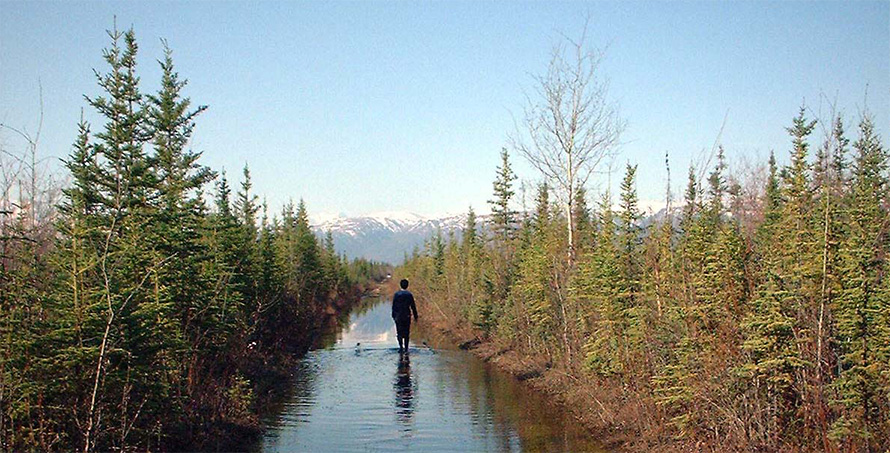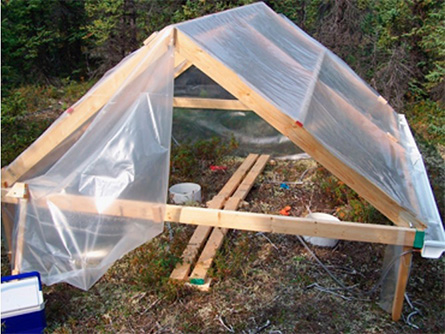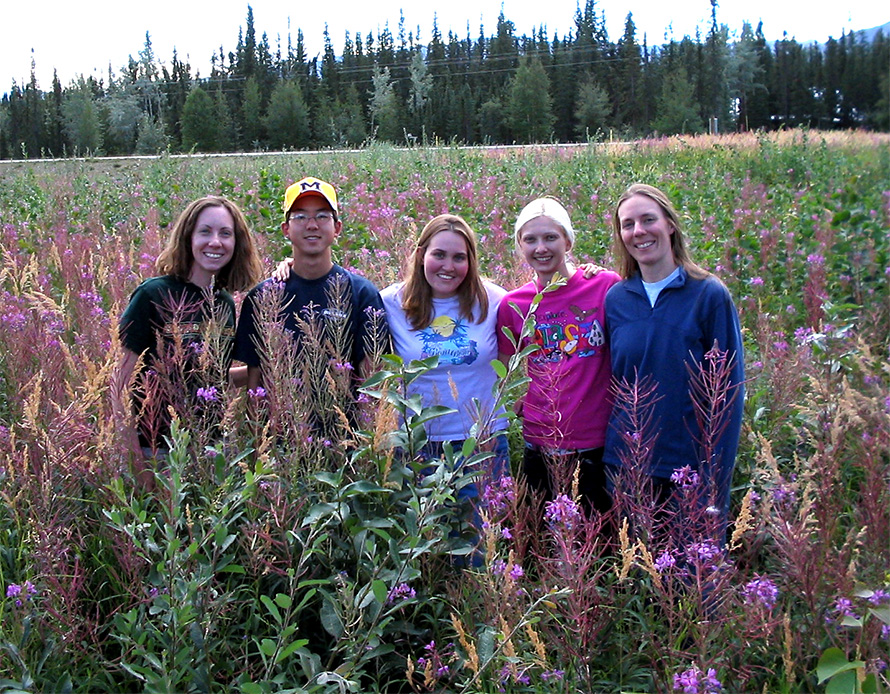
Bears, fungi and global warming
If you are going to study the Alaskan boreal forest, there are a couple of things you need to know. First, if you encounter a bear, stand your ground. But if it’s hungry enough, it still might eat you. Second, come rain, shine or storm that knocks the trees down around you, you must stay with your soil chamber and take measurements.
Kathleen Treseder knows all too well the perils and wonders of studying the Alaskan boreal forest. Sometimes called “taiga,” the boreal forest spans the interior and south central Alaskan landscape. It includes the Tongass National Forest, the largest national forest in the United States (16.8 million acres), and the Chugach National Forest, which comes in second place.
Treseder’s fieldwork out in the Alaskan forest consisted of waiting for gas to build up in a chamber — most of the time. Many plants and wildlife adapted to the cold weather call this forest home, including grizzly and black bears. “One of the things we always had to keep an eye out for was bears. … You could run across some signs that a bear had been at the site just a few minutes before we arrived,” Treseder said. “I’d be thinking, ‘I’ve got to be sure if a bear charges me not to run.’”

But the conviction that drove Treseder to Alaska was undeterred by storm or possible bear sighting. After obtaining her bachelor’s in biology from the University of Utah and her Ph.D. from Stanford, Treseder went to the University of California, Riverside, to study climate change. That’s when she began her work investigating the Alaskan forest and the little creatures existing beneath the surface.
Climate change had gotten her attention in the 1990s during her time in college. “When I was an undergrad, I worked on restoring tropical rainforests in Borneo — restoring them from logging. I was thinking a lot about all the different ways that humans were harming the environment,” Treseder says. As her studies continued, her concern grew for the environment and the impact climate change would have on her community.
Treseder’s time at UC Riverside was transformative — the beginning of a wonderful career for the climate change activist and researcher. The Alaskan forest is a prime spot for climate research, because far northern biomes house up to 30% of global terrestrial carbon in soils and plant biomass and have the potential to strongly influence atmospheric carbon dioxide concentration. Tundra and boreal forest ecosystems at higher latitudes are especially vulnerable to climate change, with projections indicating warming of 4-7°C by 2100.
“Wildfire is an example of climate change in the boreal forest because it’s getting warmer up there, and … the forest floor dries out, and it makes it very easy to burn,” Treseder said. While she was in Alaska, a huge wildfire occurred near one of her field sites. “So, we wanted to study right away — how did these fires affect the ecosystem, how fast would the ecosystem recover, and what role would fungi have in that recovery? I continued to work in that same system for the next couple of decades.”

Treseder’s 2008 publication in Global Change Biology.
Fungi are the organisms at the heart of Treseder’s longstanding research project in the Alaskan forest. This spore-producing kingdom includes a diverse range of species, such as yeasts, mushrooms and root fungi, that hold a vital role in the ecosystem. Fungi provide nutrients to plants and break down organic matter in the soil, releasing carbon dioxide, among other gases, during this process. They are a cornerstone for soil health — a fine balance that becomes disrupted by global warming, according to Treseder. “These fungi really are sensitive to climate change — all sorts of different aspects of climate change. Warming causes them to change their activities. Nitrogen pollution causes that. The fires cause them to change their activities. And a lot of times (we observe) really strong changes.”
In her warming experiments, Treseder built an on-site greenhouse over the plots of boreal soil she wanted to study. The closed top chamber of the greenhouse passively warms the soil over time, allowing Treseder to simulate the effects of global warming on the soil. Evidence gathered from her previously published warming experiments showed that higher temperatures drive fungi to decompose microbes in the soil — releasing carbon dioxide in the process. Warming also causes fungal communities to shift toward lower abundance and higher diversity. This warming-induced shift favors fungi with an increased ability to break down carbon-storing molecules resistant to decomposition, which are called recalcitrant carbon.
Treseder’s laboratory went on to show that the increased ability of fungi to break down organic matter reduces long-term soil carbon storage in the Alaskan forest. A potentially dangerous consequence is that carbon allocation moves above ground with the release of carbon dioxide during decomposition — feeding into the vicious cycle of climate change.
While fungi are small, their impact on the global environment is large. “We see plants — we know how important they are. And there are people who really care about trees … and try to protect (them),” Treseder explains. “But we just don’t see the fungi in the soil … so it’s not something that the average person really thinks about a lot.”
Yet one type of fungi in particular fights to keep the peace — mycorrhizal fungi. Mycorrhizae are a biodiverse group of many fungal species that form symbiotic associations with plant roots and provide them with key nutrients. These root fungi combat climate change by offsetting greenhouse gases and keeping carbon in the soil. “That was a huge debate right when I started — do species matter with fungi? Now we know, absolutely they do,” Treseder explains. Unfortunately, root fungi are not fire resistant. Increased wildfires driven by global warming worsen an already delicate system and drive down the root fungi population. Evidence shows that forest fires also stimulate microbial decomposition — promoting carbon dioxide release and depleting soil carbon storage over time.
Protecting the Alaskan boreal forest and other endangered ecosystems around the world is pivotal to fighting climate change. Longstanding efforts of scientists like Treseder have produced notable progress in climate understanding and research methodology. “In our field, I think we’ve been really hampered in the past by our technology,” Treseder says. “Earlier at the start of my career, we were in a discovery phase, just kind of just discovering what is out there and all of that. And now I think we are in an analysis phase and an understanding phase.”
Treseder no longer does fieldwork in Alaska, but she continues to work on the frontier of climate research as a professor at the University of California, Irvine. “What my lab’s research is tending toward now is thinking really explicitly about humans and their role in the ecosystem … and again, there’s that challenge with linking a fungus with society,” she says. “If someone decides (whether) to drink their tap water in Santa Ana, how is that linked to a fungus that is growing in the neighborhood around them? That is a tough connection to try to study — but it’s important.”
Reaching for the human connection also has led Treseder to partner with social scientists to understand better what factors can impact societal response to climate change. One topic especially has invaded the collective consciousness of climate researchers. Often, when discussing climate change, an individual may feel grief and worry about future ramifications, a phenomenon called eco-grief. Such a reaction can interfere with public engagement and inhibit climate action, a problem Treseder hopes to continue working through. “(The) intersection between social science and natural sciences is, I think, the frontier now in my research.”

Enjoy reading ASBMB Today?
Become a member to receive the print edition four times a year and the digital edition monthly.
Learn moreGet the latest from ASBMB Today
Enter your email address, and we’ll send you a weekly email with recent articles, interviews and more.
Latest in People
People highlights or most popular articles

Exploring the link between lipids and longevity
Meng Wang will present her work on metabolism and aging at the ASBMB Annual Meeting, March 7-10, just outside of Washington, D.C.

Defining a ‘crucial gatekeeper’ of lipid metabolism
George Carman receives the Herbert Tabor Research Award at the ASBMB Annual Meeting, March 7–10, just outside of Washington, D.C.

Nuñez receives Vallee Scholar Award
He will receive $400,000 to support his research.

Mydy named Purdue assistant professor
Her lab will focus on protein structure and function, enzyme mechanisms and plant natural product biosynthesis, working to characterize and engineer plant natural products for therapeutic and agricultural applications.

In memoriam: Michael J. Chamberlin
He discovered RNA polymerase and was an ASBMB member for nearly 60 years.

Building the blueprint to block HIV
Wesley Sundquist will present his work on the HIV capsid and revolutionary drug, Lenacapavir, at the ASBMB Annual Meeting, March 7–10, in Maryland.

